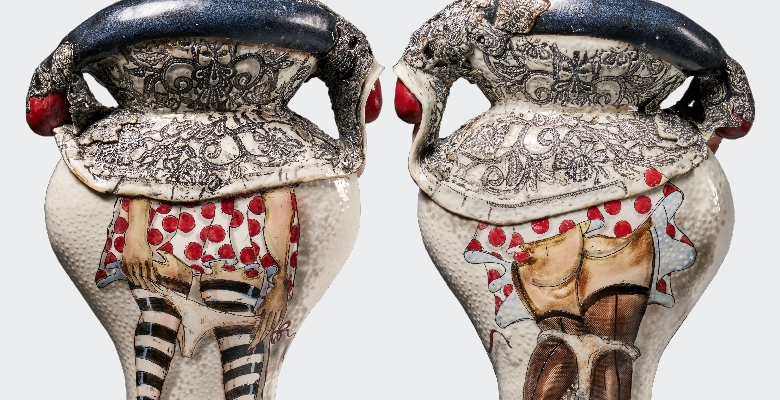The exhibition has been conceived marking the 21st anniversary of the artists’ collaboration, since their first exhibition together in Riga in 1999. That is when this creative tandem was established, and since then all their works have been signed with the surnames of both. The combination Skuja Braden symbolises another, invented personality, a kind of bandit or thief, who has appropriated the identity of two authors. While both Ingūna Skuja (1965) and Melissa D. Braden (1968) exist, only Skuja Braden is truly well known in the art world. She literally exists in a third state – created and not created, real and unreal, her existence effectively dismantles the relationship between subject and object. This is an important aspect in the oeuvre of Ingūna Skuja and Melissa D. Braden as well as in the interpretation of their ideas.
Since the creation of Skuja Braden, the duo has been active in both Latvia and the United States, taking part in exhibitions in centres of ceramic art in European countries, Asia and Australia. The works of Skuja Braden are held in more than thirty collections in Latvia and internationally – belonging to museums, institutions and organisations. Personal exhibitions are regularly organised in Latvia, paying particular attention to the regions, as well as abroad. Each year, Skuja Braden’s creations are included in many prestigious group shows, juried exhibitions and conceptual projects throughout the world, exciting and delighting porcelain aficionados from America to Australia.
The exhibitions of Skuja Braden are always an occasion. The style of the tandem’s objects is original and unparalleled. The artists work shoulder to shoulder, influencing, modifying, supplementing each other’s creations, from sketching the forms on paper all the way to the final touches of paint and glazing on the sculptural work in material. Although porcelain is a demanding material that loves planning and does not tolerate mistakes, the eccentric character of Skuja Braden does not lend itself to limitations and remains expressive, experimental, and unafraid to thread new paths in its form-creation as well as hand-painting. The technique used by Skuja Braden expands to the maximum the borders of what traditionally is possible in ceramics and porcelain art.
Along with their technique, the content of Skuja Braden’s work is just as explosive. Being feminists, defenders of LGBT, socially responsible and politically active individuals, Ingūna Skuja and Melissa D. Braden acutely record what is happening around them – people and events in culture, political shifts and the way that affects society and the individual – is all interpreted in their work. Skuja Braden takes the position of a militant critic or a loving supporter, but never remains neutral or stands aside. Such a conscious, loudly formulated and unapologetic position is unique in the Latvian art scene.
The dualism characteristic of Skuja Braden also takes another form: alongside pieces which are made as a reaction to the current physical reality, an important aspect of their work is activity influenced by Buddhism, acceptance and reliance on an understanding of the eternal, the timeless.
The exhibition Samsara characterises the way Skuja Braden understands and practices Buddhism. Originating in India, the core concept of samsara is prevalent in Eastern religions, and is created through a false understanding of the mind which creates a false self that leads us through perpetual cycles of existences in the unreal world of samsara. At the same time, samsara is the organising principle of the exhibition space and the choreography of its perception – the prism through which to see and perceive the tandem’s material creations.
The exhibition at the Museum of Decorative Arts and Design brings together more than 200 art objects from museum and private collections. The exposition is divided into eight thematic groups which, on the one hand, illustrate different types of work and approaches employed by Ingūna Skuja and Melissa D. Braden, while, on the other, formulates subjects that are important in the oeuvre of Skuja Braden. The central axis of the exhibition is formed by the themes of life and death. The works exhibited in The Room of Desire have been created, drawing inspiration from Japanese Shunga prints, the art of Sigismunds Vidbergs, Greek erotic vases and Latvian naughty folksongs, continuing to develop this aspect of art. Meanwhile Altar is like a shrine for leaving alms and praying for assistance from ancestors’ spirits.
Section People We Know, People We Would Like to Know and People We No Longer Want to Know is a gallery of portraits painted on round and oval plates. Here the visitor can encounter Marilyn Monroe, Mahatma Gandhi, people popular in Latvia, Latvian and US presidents and others and then try to determine the category in which Skuja Braden has placed them. Groups of porcelain and works of visual art – vases, figural objects, abstract shapes, drawings and paintings reveal allegoric interpretations for The Seven Heavenly Virtues and the Seven Deadly Sins, Hybrid Forms and Musical Boxes, Theory Is What We Hang Our Hats On, Form and Emptinessand With the Ideal Comes the Actual. The show vividly demonstrates the broad spectrum of both authors’ oeuvre and simultaneously their shared history, particularly highlighting their most recent period and works created especially for this exhibition.
Text by Iliana Veinberga, Irēna Bužinska

EXHIBITION CREATIVE TEAM:
Skuja Braden: Ingūna Skuja and Melisa D. Breidena (Melissa D. Braden), artists
Iliana Veinberga, art historian
EXHIBITION CO-ORDINATOR
Irēna Bužinska, Exhibition Curator, Museum of Decorative Arts and Design /
Latvian National Museum of Art
EXHIBITION DESIGN:
Skuja Braden
INSTALLATION:
AH! OH! Ltd., Gundega Evelone, Andris Landaus, Uldis Timoško




